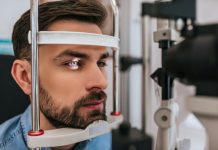
Scientists from the Geneva University Hospitals found that COVID-19 infections may cause retina damage.
They that 11% of people hospitalized for respiratory distress due to COVID-19 disease have retinal damage.
The research is published in the Journal of Clinical Medicine and was conducted by Eleonora Riotto et al.
Since the first pandemic wave of SARS-CoV-2, scientists, and physicians have observed brain and vascular damage in patients.
The retina is part of the nervous system and offers a direct and non-invasive observation pathway to the vessels.
In the study, the team tested 172 people infected with SARS-CoV-2.
They found a photograph of the back of the eye gives access to the vascular system of the retina, which makes studying COVID-19 vessel disease easily.
The examination revealed white spots on the retinas in 11 percent of cases. These spots are signs of retinal suffering secondary to small artery occlusion.
They can be caused by embolism or inflammation of the retinal vessels, with vasculitis creating an obstruction to blood circulation and potentially a lack of oxygen and nutrients.
They are mostly seen in people with diabetes or high blood pressure.
These data were then cross-referenced with the health status of the individuals and their symptoms.
The team found a history of diabetes, overweight, and elevated C-reactive protein—whose expression reflects inflammation following infection or tissue damage—were more frequently observed in patients with cotton wool spots.
However, although there was a link with diabetes, the study showed that nearly 64% of the participants with retinal abnormalities did not previously have diabetes.
The same was true for high blood pressure since nearly 90% of the patients with retinal damage had no history of hypertension to explain this phenomenon.
The research team believes that three different mechanisms could explain them.
First, direct tissue damage by virus infiltration into the endothelial cells of vessels could cause inflammation and vascular obstruction.
A second explanation is the potential occlusion of retinal arterioles caused by a state of hypercoagulability in relation to the deposition of fibrin clots observed in many studies with COVID-19.
The last hypothesis suggests that the cotton wool spots occur as a result of under-oxygenation related to the acute respiratory distress or the elevated blood pressure typically seen in the early phase of COVID-19 disease.
If you care about COVID, please read studies that new inhaled vaccine delivers broad protection against COVID-19, and herb rosemary could help fight COVID-19, Alzheimer’s disease.
For more information about COVID, please see recent studies about the key to stopping indoor COVID virus spread, and results showing vitamin D3 could help people fight COVID-19, infections.
Copyright © 2022 Knowridge Science Report. All rights reserved.



